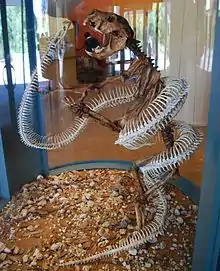Wonambi
Wonambi is an extinct genus of madtsoiid snakes that lived in late Neogene to late Quaternary Australia. Species of Wonambi were constrictor snakes unrelated to Australian pythons.
| Wonambi | |
|---|---|
 | |
| Wonambi naracoortensis and Thylacoleo | |
| Scientific classification | |
| Kingdom: | Animalia |
| Phylum: | Chordata |
| Class: | Reptilia |
| Order: | Squamata |
| Suborder: | Serpentes |
| Family: | †Madtsoiidae |
| Genus: | †Wonambi |
| Type species | |
| Wonambi naracoortensis Smith, 1976 | |
| Species | |
|
†Wonambi barriei Scanlon, 2000 | |
Diversity
The type species is Wonambi naracoortensis, a five to six metre long snake that was a member of the Pleistocene Australian megafauna; the only other known species is Wonambi barriei from the Miocene-aged Riversleigh fauna.[1]
Description
Wonambi is a genus of non-venomous, constrictor snakes, it seems to have been an ambush predator that killed its prey by constriction. The head of the animal was small, restricting the size of its prey.
Taxonomy and naming
Wonambi naracoortensis was first described from fossils collected at Naracoorte, South Australia, the first extinct snake to be found in Australia.[2]
It was given the name Wonambi from the description, by the local Aboriginal people, of a serpent of the Dreamtime. This serpent, a mythological being commonly referred to by both Aboriginal people and Europeans as the Rainbow Serpent, was often held responsible for the creation of major features of the landscape. The Wagyl of the Western Australian Noongar people is thought to correlate to the South Australian people's Wonambi. It is cognate with the Yurlunggur genus, found at Riversleigh in Queensland and in the Northern Territory, which was up to 9 metres (30 ft) long with a body about 30 centimetres (12 in) in diameter.
The family of this species, Madtsoiidae, became extinct in other parts of the world around 55 million years ago, but new species continued to evolve in Australia. These species are the last known to have existed, becoming extinct in the last 50,000 years.
Ecology
Wonambi naracoortensis lived during the Pleistocene Ice Age period, in natural sun-traps beside local waterholes, where they would ambush kangaroo, wallaby and other prey coming to the water to drink. For this reason, children were forbidden in Aboriginal culture to play at such places, and only allowed to visit when accompanied by an adult. Mapping such locations in Western Australia, has been found to be closely associated with areas the Noongar people regard as Waugal sacred sites.
Tim Flannery claims that this animal, along with other Australian megafauna, became extinct (partly) as a result of activities of Aboriginal Australians (for example, hunting and firestick farming).[3]
See also
References
- John D. Scanlon; Michael S. Y. Lee (January 2000). "The Pleistocene serpent Wonambi and the early evolution of snakes. FIGURE 2. Selected elements of Wonambi exhibiting phylogenetically important characters". Nature. 403 (6768): 416–420. doi:10.1038/35000188. PMID 10667791. S2CID 4404799.
- Ehmann, Harald (1993). "33. Family Boidae" (PDF). In C.G.Glasby G.J.B.Ross P.L.Beesley (ed.). Amphibia and Reptilia. Fauna of Australia. 2A (Online ed.). Australian Government Publishing Service. p. 15. ISBN 978-0-644-32429-8.
- Flannery, Tim (1994). The Future Eaters: An Ecological History of the Australasian Lands and People, ISBN 0-8021-3943-4 ISBN 0-7301-0422-2
